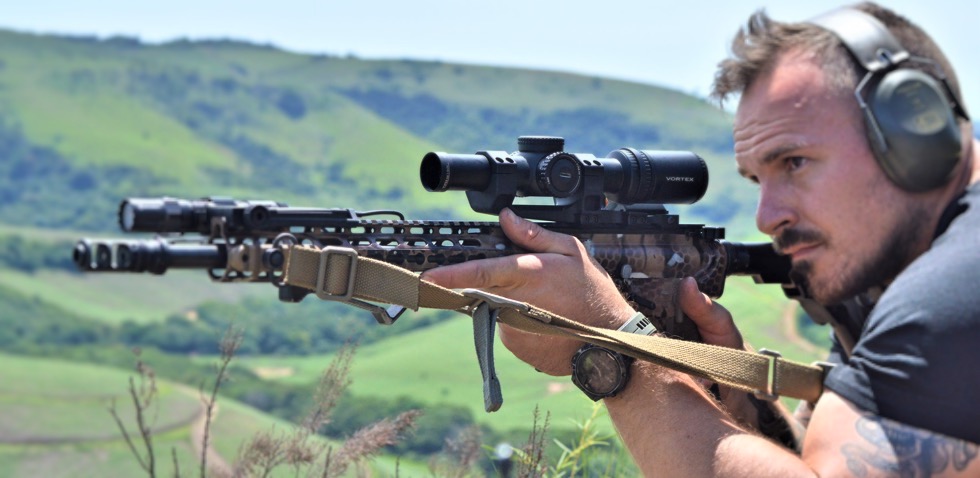The tactical rifle sling – or the sling commonly associated with semi-automatic rifles – has evolved tremendously in recent years. The industry-leading two-point slings have some seriously ingenious design behind them, often understood by only the truest of rifle enthusiasts. So should you be using a sling on your tactical rifle, and if so, then which kind?
If your tactical rifle or carbine is used anywhere aside from a static firing range, then you most likely require a sling. This is even more applicable when your rifle is used for self defence or professional duty. But why? Well, a good rifle sling effectively serves as a holster for your long gun, providing some essential and very useful advantages, from weapon retention, to freeing up your hands, providing stability for those longer shots, and allowing for a smooth transition from rifle to pistol when needed. While there are a number of sling designs available on today’s market, the two-point sling is undoubtably the only option offering all of the benefits listed above.
Today we are going to comprehensively discuss all things sling related, in a tactical manner of course. This will include sling selection and setup, proper use and techniques, along with some small tips and tricks that i’ve picked up along the way. So stay tuned!
The Benefits Of Using A Tactical Rifle Sling
As we have already discussed, the rifle sling is often thought of as a holster for your long gun, providing some essential and very useful advantages.
- A good sling keeps your rifle attached to your person, allowing you to perform a multitude of other tasks with both hands when needed. This is an important factor to consider if you have friends or family members who may require medical assistance or physical handling, or if you foresee the need to navigate over awkward or unruly obstacles that may be in your way.
- Slings also provide valuable weapon retention, making it a lot harder for an accomplice to forcibly take your rifle from you by surprise. This may seem unlikely, but we have seen plenty of video evidence in recent years whereby civilians have been disarmed during riots and civil unrest scenarios.
- Some slings can help to stabilise your aim for more accurate shooting, particularly the modern two-point sling. When employed correctly, the sling has an astonishing ability to improve shooting accuracy when taking shots from an unsupported position while standing, kneeling or sitting.
- A sling also allows the shooter to transition from rifle to pistol in a rapid and smooth progression, without needing to drop the primary firearm onto the deck – a vital skill needed when operating in close quarters.
Which Rifle Sling Is Best For You?
Before giving my own recommendation on which sling would most likely serve you best, let’s briefly discuss the three most common types of rifle sling out there.
The Single-Point Sling

The single-point rifle sling is extremely popular amongst novice and expert shooters alike, allowing the firearm to hang free – vertically. The simple design wraps around the body and is attached to a single point at the end of the rifle’s receiver. This type of design can accommodate a variety of shooting positions and can be switched from one shoulder to the other with ease, but it lacks the ability to enhance accuracy by providing support. Another disadvantage is that the rifle swings freely when let go, and has a tendency to plonk itself directly into the family jewels.
Verdict: OUTDATED
The Two-Point Sling

The two-point sling attaches to the rifle at – you guessed it – two separate points. It allows the shooter to carry the rifle diagonally across the front or back of the body in a comfortable and secure manner. There are a number of modern and versatile two point slings on the market today which allow for a variety of carry positions, while also providing additional support when shooting over longer distances. A few of my favourite brands include Blue Force Gear, Viking Tactics and Magpul.
Verdict: RECOMMENDED



The Three-Point Sling

The three-point sling operates by a 3-point attachment method; two points at either end of the rifle, and one between the rifle and body. The sling design allows for the widest variety of carrying options, but is more complex to use. These slings only work well on rifles designed with operating parts along only one-single side of the firearm. When used on an AR-15 rifle for example, the sling gets in the way of the safety catch, bolt release catch and charging handle, and is more of a nuisance than anything.
Verdict: BIN IT
My Advice
Having been through and thoroughly used all three sling types in the past:
- The three-point in the British military for a period of 6 years
- Single-point as a private contractor, tactical firearms instructor and civilian for around 3 years
- And finally the two-point for the past 4 years, as a private contractor, tactical firearms instructor and civilian
I would unquestionably recommend using an industry-leading two-point sling. If the price is too high, then there are some alternate two-point (generic) options that can be found on amazon.
How To Mount [Or Setup] Your Rifle Sling
Deciding where to mount or attach your sling can be a challenging task, especially considering the various options available. The best advice I can give is to try them all, and see what works best for you under a proper training environment.
The following two images provide an example of how I typically attach my two-point sling to my rifle. Feel free to comment below if you have any questions or need a better understanding on what you are seeing.


Front Attachment Point: on the left-hand side, to the rear 1/3rd of the handguard. This allows for the least amount of interference by the sling when changing magazines and operating the bolt release catch.
Rear Attachment Point: Threaded through (not over/around) the rear sling slot, on the right-hand side. This prevents the sling from choking the throat when mounting the rifle in the opposite shoulder, while still operating the pistol grip with the shooting/strong hand.
Note: the above setup is tailored to work in conjunction with a right-handed shooter. When QD sling mounts are available, the setup remains the same.
Do You Need QD (or Quick Detachable) Sling Mounts?
The quick detachable (QD) sling mount and paired sling swivel has become a popular accessory amongst modern tactical firearms. But are they really necessary? The answer really depends on your intended use. While they won’t change how the rifle operates or feels, nor the durability of the sling attachment points themselves, there are some circumstances where QD sling mounts certainly make life a lot easier. These are as follows:
- If you use your rifle sling amongst various rifles, the QD mount makes the changeover effortless
- If you share the rifle with a left-handed shooter, then QD swivels allow the sling position to be altered within seconds. This also applies to users who have multiple attachment points along the rifle’s handguard for various applications.
- The QD swivel also allows shooters to easily and rapidly remove the sling from the rear of the rifle when used at the front end to provide stability and consistency in jump angle – although this is more precision rifle/DMR related. This is relevant when firing over longer distances and from unsupported positions, whereby the sling is tensioned using an object towards the front end of the rifle, pulling the front end down and providing a much more stable shooting platform.




Using A Tactical Rifle Sling For Support And Stability
There are various ways in which a rifle sling can be used to promote accuracy and reduce jump angle when firing over longer distances. Since today’s article is relevant to tactical rifles and carbines (and not precision rifles), we are going to keep this section simple and introduce you to a technique known as the hasty sling, or steady sling position.
The hasty sling is best used when rifle support is unavailable, and your target sits a fair distance away – let’s say between 100 to 350 meters and beyond. The technique is rapid to adopt, can be used from the standing, kneeling and sitting position, and truly does improve stability – when practiced regularly of course.
The following video is short and to the point, demonstrating how you can manipulate your sling to aid accuracy, adopting the hasty sling position. When trying this at home (or on the range), just make sure the tension is set correctly and the sling is not sitting too loose.
Note: I am aware of the fact that many shooters do not agree that the hasty sling is beneficial. However, I certainly notice an improvement in my shooting ability over medium distances, and I will firmly stick by those who practice and understand this position as a method of improving accuracy when other support is either unavailable, or too slow to adopt under a given scenario.
Conclusion
Modern slings made by reputable companies can be costly, especially since many shooters see them as non-essential items. But as tactical skill and proficiency develops, you will certainly start to see the importance of using one, especially if you have worked as a rifleman/rifle operator in hostile areas.
After today’s article, I hope that I have given some good advice on rifle slings and uses. If you enjoyed reading this post and found it useful, don’t keep it to yourself; help us spread the word – select a social share button below. And should you wish to share your thoughts or ask a question, scroll down and leave us a comment 🙂

